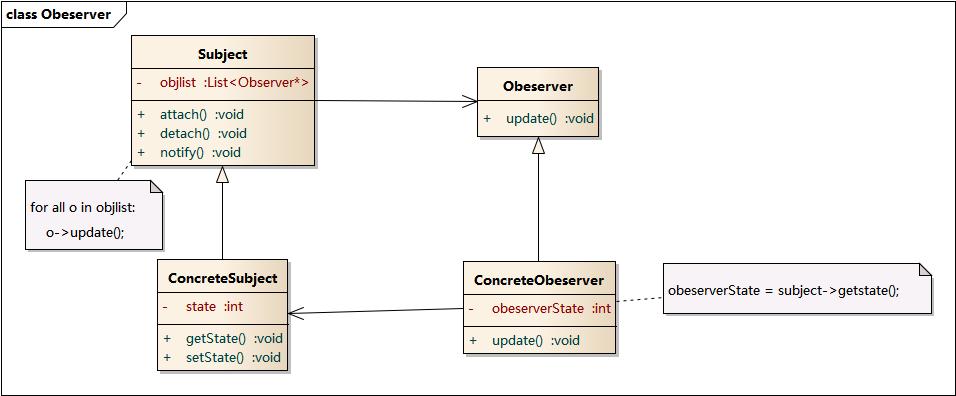参考:
https://www.cnblogs.com/geek6/p/3951677.html
https://www.cnblogs.com/java-my-life/archive/2012/05/16/2502279.html
https://blog.csdn.net/niunai112/article/details/79900699
http://c.biancheng.net/view/1390.html
https://www.runoob.com/design-pattern/observer-pattern.html
一:基本理论
观察者模式可以说是用的超级多了,先看基本概念
建立一种对象与对象之间的依赖关系,一个对象发生改变时将自动通知其他对象,其他对象将相应做出反应。在此,发生改变的对象称为观察目标,而被通知的对象称为观察者,一个观察目标可以对应多个观察者,而且这些观察者之间没有相互联系,可以根据需要增加和删除观察者,使得系统更易于扩展,这就是观察者模式的模式动机。
观察者模式包含如下角色:
- Subject: 目标
- ConcreteSubject: 具体目标
- Observer: 观察者
- ConcreteObserver: 具体观察者

代码:
public interface Observer {
public void update();
}
public class Observer1 implements Observer {
@Override
public void update() {
System.out.println("observer1 has received!");
}
}
public class Observer2 implements Observer {
@Override
public void update() {
System.out.println("observer2 has received!");
}
} public interface Subject {
/*增加观察者*/
public void add(Observer observer);
/*删除观察者*/
public void del(Observer observer);
/*通知所有的观察者*/
public void notifyObservers();
/*自身的操作*/
public void operation();
}
public abstract class AbstractSubject implements Subject {
private Vector<Observer> vector = new Vector<Observer>();
@Override
public void add(Observer observer) {
vector.add(observer);
}
@Override
public void del(Observer observer) {
vector.remove(observer);
}
@Override
public void notifyObservers() {
Enumeration<Observer> enumo = vector.elements();
while(enumo.hasMoreElements()){
enumo.nextElement().update();
}
}
}
public class MySubject extends AbstractSubject {
@Override
public void operation() {
System.out.println("update self!");
notifyObservers();
}
} public class ObserverTest {
public static void main(String[] args) {
Subject sub = new MySubject();
sub.add(new Observer1());
sub.add(new Observer2());
sub.operation();
}
}
二:Java中提供的现成接口
比较常用的设计模式,JDK中都会提供现成的实现
比如动态代理,有InvocationHandler这个类
观察者模式也同样有现成的支持
/**
* A class can implement the <code>Observer</code> interface when it
* wants to be informed of changes in observable objects.
*
* @author Chris Warth
* @see java.util.Observable
* @since JDK1.0
*/
public interface Observer {
/**
* This method is called whenever the observed object is changed. An
* application calls an <tt>Observable</tt> object's
* <code>notifyObservers</code> method to have all the object's
* observers notified of the change.
*
* @param o the observable object.
* @param arg an argument passed to the <code>notifyObservers</code>
* method.
*/
void update(Observable o, Object arg);
}
/**
* This class represents an observable object, or "data"
* in the model-view paradigm. It can be subclassed to represent an
* object that the application wants to have observed.
* <p>
* An observable object can have one or more observers. An observer
* may be any object that implements interface <tt>Observer</tt>. After an
* observable instance changes, an application calling the
* <code>Observable</code>'s <code>notifyObservers</code> method
* causes all of its observers to be notified of the change by a call
* to their <code>update</code> method.
* <p>
* The order in which notifications will be delivered is unspecified.
* The default implementation provided in the Observable class will
* notify Observers in the order in which they registered interest, but
* subclasses may change this order, use no guaranteed order, deliver
* notifications on separate threads, or may guarantee that their
* subclass follows this order, as they choose.
* <p>
* Note that this notification mechanism has nothing to do with threads
* and is completely separate from the <tt>wait</tt> and <tt>notify</tt>
* mechanism of class <tt>Object</tt>.
* <p>
* When an observable object is newly created, its set of observers is
* empty. Two observers are considered the same if and only if the
* <tt>equals</tt> method returns true for them.
*
* @author Chris Warth
* @see java.util.Observable#notifyObservers()
* @see java.util.Observable#notifyObservers(java.lang.Object)
* @see java.util.Observer
* @see java.util.Observer#update(java.util.Observable, java.lang.Object)
* @since JDK1.0
*/
public class Observable {里面有各种接口都是和观察者模式有关的。
三 现实中的例子
Rxjava用观察者模式用的比较多,后面讲Rxjava的时候细讲
























 1455
1455











 被折叠的 条评论
为什么被折叠?
被折叠的 条评论
为什么被折叠?








